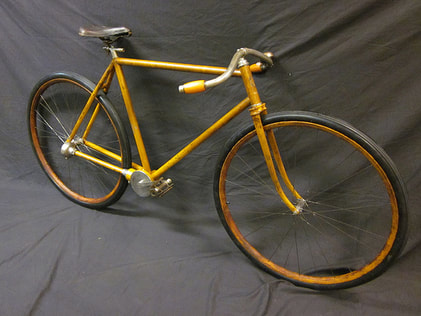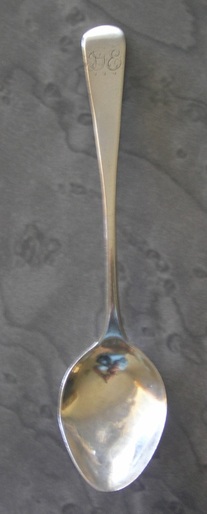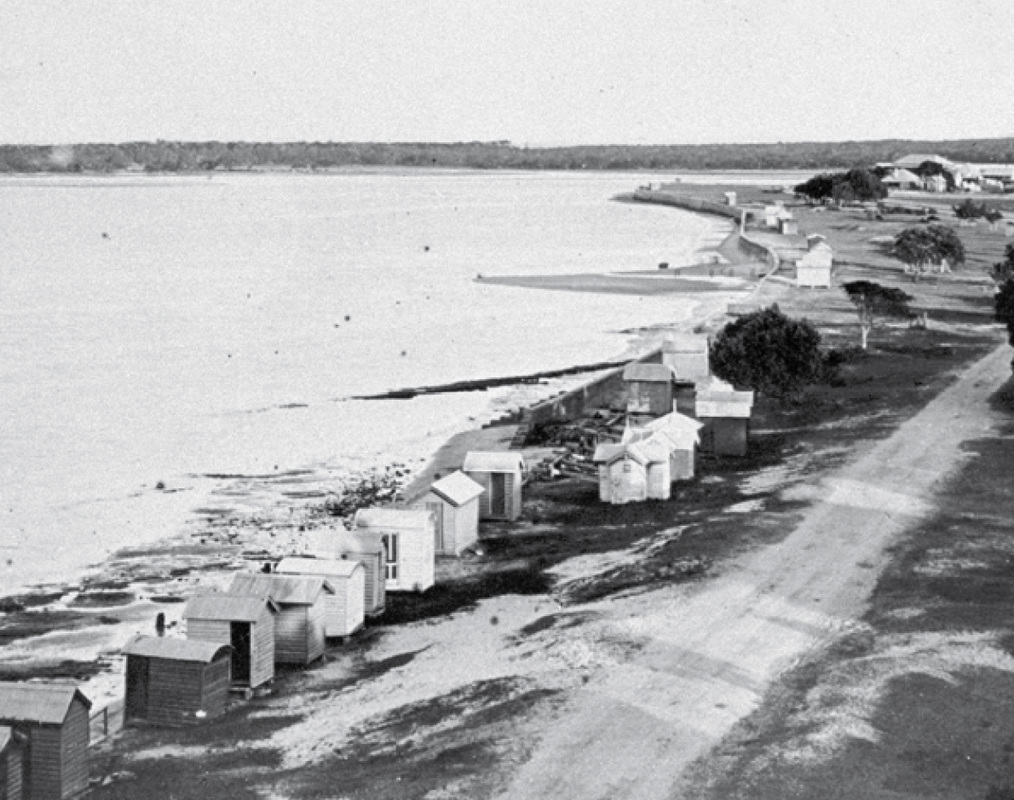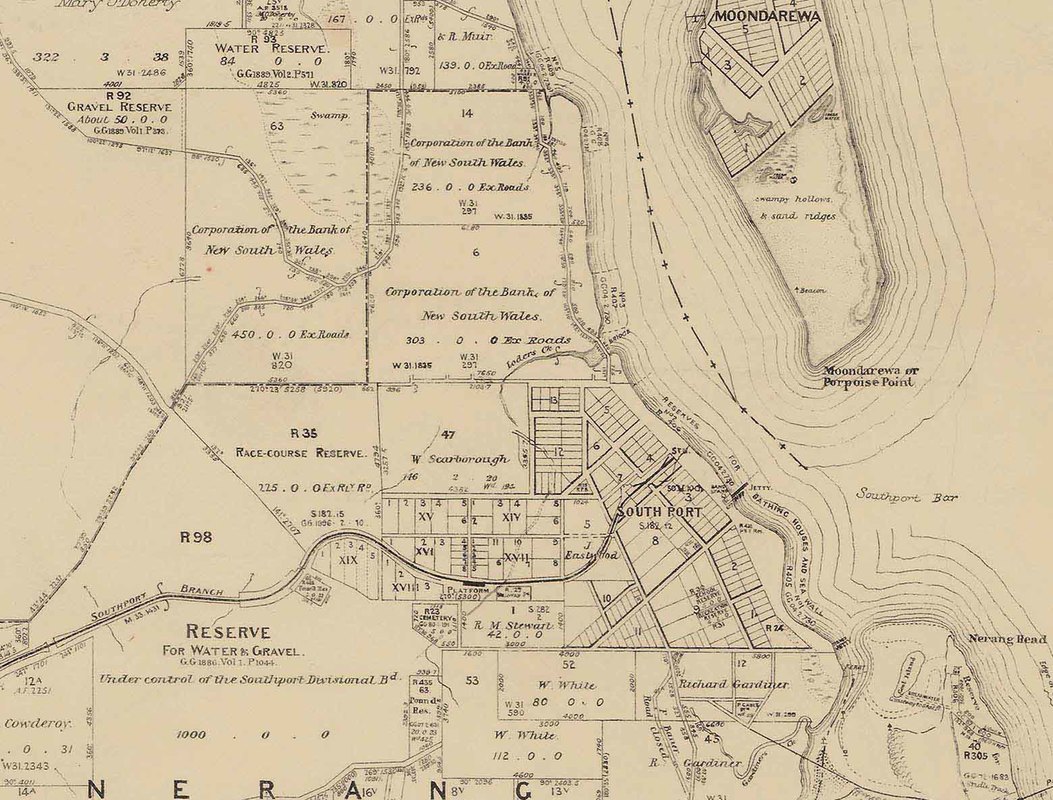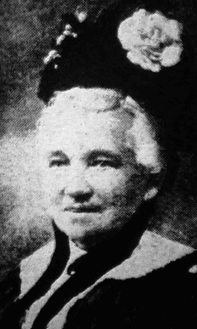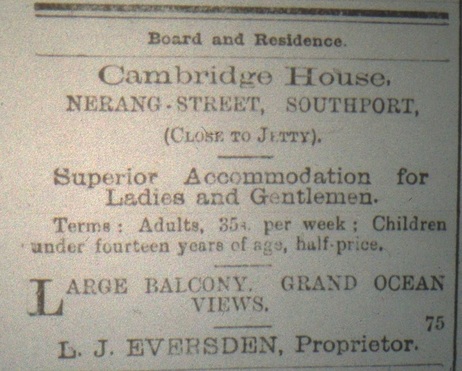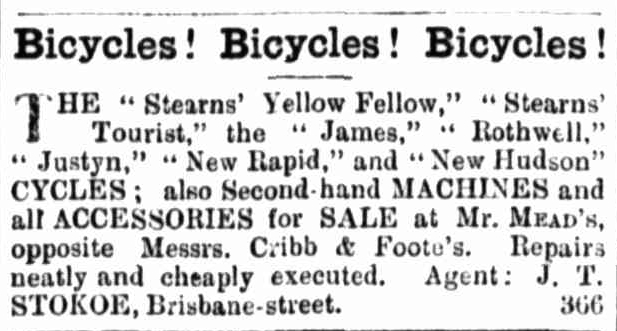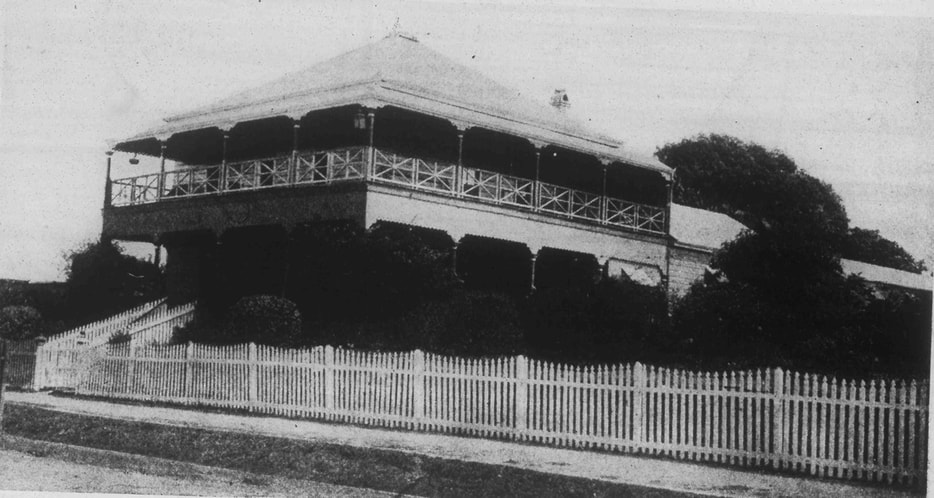
Cambridge House, Nerang St, Southport, around the turn of the Century.
1897 Hammerchewer at Cambridge House
"Hammerchewer" wrote several articles for the Queensland Times lauding the benefits of the cycling weekend. He was at his best in this article, which has particular relevance to the McLarans of Dalby.
27 Aug 1897 Queensland Times
Three-Day Bicycle Tour to Southport and Back. (By Hammerchewer)
On Tuesday morning, the 17th instant - a most beautiful morning - the writer and two friends, each mounted on a Stearns' "Yellow Fellow," left the Fountain at a quarter-past 6, on route for Southport. All were clad in appropriate costume-bike shoes, knickers and stockings etc. The luggage carrier on each machine contained nothing superfluous, just a little parcel of "tucker" and a small bundle of "togs" for cyclists know the value of the instruction to "lay aside every weight," whether they attend to the next portion of the text or not. I may say that none of the tourists on this occasion regard the bicycle merely from the scorcher's standpoint - that is, simply as a machine for piling on the greatest possible number of miles in the shortest possible number of hours - but as a delightful means of getting out into the country and seeing what is beautiful in landscape (and waterscape, too, in this instance) and inhaling the beautiful fresh air of the country, and the ozone of the ocean, as the case may be. Notwithstanding this fact, they are not strangers to the delightful experience of flying along at the rate of from 12 to 15 miles an hour with scarcely any effort on many parts of the capital road between Oxley and Beenleigh and Pimpama.
Three-Day Bicycle Tour to Southport and Back. (By Hammerchewer)
On Tuesday morning, the 17th instant - a most beautiful morning - the writer and two friends, each mounted on a Stearns' "Yellow Fellow," left the Fountain at a quarter-past 6, on route for Southport. All were clad in appropriate costume-bike shoes, knickers and stockings etc. The luggage carrier on each machine contained nothing superfluous, just a little parcel of "tucker" and a small bundle of "togs" for cyclists know the value of the instruction to "lay aside every weight," whether they attend to the next portion of the text or not. I may say that none of the tourists on this occasion regard the bicycle merely from the scorcher's standpoint - that is, simply as a machine for piling on the greatest possible number of miles in the shortest possible number of hours - but as a delightful means of getting out into the country and seeing what is beautiful in landscape (and waterscape, too, in this instance) and inhaling the beautiful fresh air of the country, and the ozone of the ocean, as the case may be. Notwithstanding this fact, they are not strangers to the delightful experience of flying along at the rate of from 12 to 15 miles an hour with scarcely any effort on many parts of the capital road between Oxley and Beenleigh and Pimpama.
|
Stearns' Yellow Fellow
|
Now as to the road from Ipswich to Oxley, it was very dusty and much cut up owing to the traffic and the want of a good shower of rain. After crossing Oxley Bridge the road indicated by finger-post as leading to Cooper's Plains is taken, leaving the Brisbane-road to the left. From here to Beenleigh it is very good in fact, after passing the finger-post at the junction of the road to Waterford and Logan Village with that to Beenleigh, it is splendid, travelling on the last 10 or 12 miles on this side of the Loganholme Ferry, about 1 1/2 mile from Beenleigh, being like riding through an avenue in a gentleman's domain. From Beenleigh to Pimpama the road is good, and, from thence to the Coomera only middling, there being some tough ridges to negotiate, which necessitate a good bit of walking.
|
After crossing the Coomera River by ferry there are 3 or 4 miles of good road, after which from there to Southport Cemetery the thoroughfare is very bad - in short, I am not sufficiently conversant with my mother tongue to describe some portions of it; it would require the vocabulary of a case-hardened bullock-driver to do anything like adequate justice to it.
As to distances: Those following are as recorded by our cyclometers - each of us having one attached to his machine. On arriving at Beenleigh the instruments showed 37 miles traversed; at Pimpama, 48 miles; Coomera Ferry, 58, miles; and Southport (Mrs. Eversden's), 65 miles.
As to distances: Those following are as recorded by our cyclometers - each of us having one attached to his machine. On arriving at Beenleigh the instruments showed 37 miles traversed; at Pimpama, 48 miles; Coomera Ferry, 58, miles; and Southport (Mrs. Eversden's), 65 miles.
|
A teaspoon from Cambridge House.
Manufactured around 1825, the owner, James Eversden 1791 - 1859, engraved his and his new wife's initials on the handle. James's son, Lewis James Eversden, brought cutlery with him on the Flying Cloud. Photo courtesy Veronica P. Spoon interpretation by Graham Eversden, UK. |
On arriving there, as one of our number had never visited the "queen"' of watering places before, a delightful spin round the town was indulged in, which proved very enjoyable after "plugging" over the wretched road of the last 8 or 10 miles. We then fixed up at Mrs Eversden's, and after a wash etc, felt quite "fit" when the welcome tea-bell rang. I believe the writer put up a record at the tea-table on that occasion, though his companions came in a good second. Indeed, I noticed that the cyclists were always longest at the table during our stay.
After tea we went in for a bit of wild dissipation by going to the railway station to see who were coming, and among the arrivals we welcomed a well known Ipswich wheelman, who had been ordered hither for a change. His wheel was in the brake-van, however, and we were gratified to find that his destination was Mrs. Eversden's. All then made tracks for the jetty, where some excellent work in the piscatorial line was being done. One old gentleman was hauling in splendid bream one after another in grand fashion. Each of the tourists tried his hand, but without success. We then sought our couches, and had a good night's repose, though we did no record work in this line, being up early and at the fishing again. On this occasion the writer was successful for the first time in his life - that is, if oysters are fishes, for a few dozen rock oysters fell victims to his prowess. The other two were more fortunate, or displayed better skill, for they each succeeded in their efforts with the line, and landed some choice specimens of the finney tribe. |
|
After a sumptuous breakfast, which was enjoyed as only cyclists can enjoy a meal, a nice spin as far as the Governor's marine residence, and then back past the Grand Hotel and as far as Woodlands, was enjoyed. On the way back we were shown through the Grand Hotel, from the tower of which a splendid view is obtained, embracing the Tweed Heads - I believe about 25 miles off. The remainder of the day was occupied chiefly in fishing.
At night the Salvation Army Band fetched me out, and, after listening to the open-air service, I followed them up to the barracks, where a characteristic Army meeting was run. While this was going on, one of our fellow-boarders caught thirty-six fine bream off the jetty, the admirable quality of which was abundantly proved next morning at breakfast. |
Southport Broadwater around 1900.
|
1917 Map of Southport
Note:
Note:
- the then location of the bar
- the bathing houses and the railway station (in today's Railway Street)
- Nerang Street is just south of the jetty.
|
After a good night's rest, we were up early, and "on the job" for the return journey, being in first-class fettle for breakfast and for the road. Owing to the execrable nature of the most part of the thoroughfare between Southport and Pimpama, we decided to train it as far as the latter place, and left Mrs. Eversden's excellent house to catch the 7:20 train.
On arriving at Pimpama we held a general inspection of our mounts, did an "oil up," and started in great form, the morning being a most delicious one. On crossing the bridge over the Albert River, two miles from Beenleigh, we visited the Beenleigh Co.'s sugar-mill, and were very kindly shown the whole process of manufacture from crushing the cane as it is brought in from the field to the finished product ready for the grocer's counter. We did the school-boy racket by chewing cane at one end and eating sugar as it was being weighed and bagged at the other. I understand that about seventy-five tons of cane per day are put through here. |
1909 Mrs Eversden - Jane Rider.
|
After spending a very pleasant and interesting, and I may say educative, time here, we remounted, and in a few minutes were enjoying a first-class luncheon in the dining-room of the Imperial Hotel, close to the railway station, for which we only paid 1s. each, though I verily believe we ate half a crown's worth each. Beenleigh is a nice little place, in which the German element is much in evidence.
After a good look round, a glorious run brought us to near Oxley, where a stop was made at the house of one of our numerous friends on this track, and we were soon outside of a big jug of milk produced here and a large bundle of ham sandwiches which the kindly forethought of Mrs. Eversden had provided us with in the morning.
The next pull-up was at Goodna, where three bottles of soft-tack were disposed of. Then, on passing the residence of Captain Ackerley, a little on this side of the new Six-mile Bridge, we responded to the kind invitation of that gentleman, and were soon squatting on his verandah, where another big jug of milk and an unknown quantity of biscuits disappeared.
About 5 o'clock Brisbane-street was reached; without a single accident of any description whatever to either men or machines during the whole tour, during which 126 miles were registered. As to expenditure: Well, we had everything first-class (that goes without saying when you are staying at Mrs. Eversden's); and yet the total cost of the tour to each of us, including 2s. 9d. each for railway fare for selves and machines from Southport to Pimpama on the return trip and ferry dues both ways, was only 14s. 4d.
Do I believe in the bike? Rather!! I think when three busy businessmen can get away from the everlasting grind for even three days, and enjoy themselves, as we did, for 14s. 4d., the bike is worth consideration. We all feel more "fit" in every way for our regular work than before, and our excursion is a very pleasant recollection.
After a good look round, a glorious run brought us to near Oxley, where a stop was made at the house of one of our numerous friends on this track, and we were soon outside of a big jug of milk produced here and a large bundle of ham sandwiches which the kindly forethought of Mrs. Eversden had provided us with in the morning.
The next pull-up was at Goodna, where three bottles of soft-tack were disposed of. Then, on passing the residence of Captain Ackerley, a little on this side of the new Six-mile Bridge, we responded to the kind invitation of that gentleman, and were soon squatting on his verandah, where another big jug of milk and an unknown quantity of biscuits disappeared.
About 5 o'clock Brisbane-street was reached; without a single accident of any description whatever to either men or machines during the whole tour, during which 126 miles were registered. As to expenditure: Well, we had everything first-class (that goes without saying when you are staying at Mrs. Eversden's); and yet the total cost of the tour to each of us, including 2s. 9d. each for railway fare for selves and machines from Southport to Pimpama on the return trip and ferry dues both ways, was only 14s. 4d.
Do I believe in the bike? Rather!! I think when three busy businessmen can get away from the everlasting grind for even three days, and enjoy themselves, as we did, for 14s. 4d., the bike is worth consideration. We all feel more "fit" in every way for our regular work than before, and our excursion is a very pleasant recollection.
Q & A: Questions and (possible) Answers:
|
Q1. Where was the Stearn's Yellow Fellow manufactured?
A1. Stearns was a leading American bicycle manufacturing company in the 1890's. Q2. How would Hammerchewer have known about Cambridge House? A2. L.J. Eversden advertised heavily in newspapers, particularly the Queensland Times. Q3. Where would have Hammerchewer purchased his bicycle? A3. J.T. Stokoe, opposite Cribb & Foote. Q4. The Big Question: Who was "Hammerchewer"? A4. We may never discover who wrote the article under the name of "Hammerchewer".However, one very strong candidate would have to be the legendary T.J. Barker 1855 - 1924. Barker was a journalist with the Queensland Times from 1890 to his death in 1924. He was an authority on all sports, particularly cricket, and wrote under various pseudonyms such as "Old Sport" and "Red Gum". Barker's parents arrived in Moreton Bay aboard the General Hewitt, along with Jane Rider (Mrs Eversden) and Captain Thomas Huntley Brown. He was an authority on the early days and pioneers of Ipswich, particularly the passengers on the General Hewitt. By publishing this article, the Queensland Times managed to reward two of their regular customers with free advertising. |
A typical advertisement for Cambridge House in the Queensland Times.
1897 J.T. Stokoe advertisment in the Queensland Times.
|
